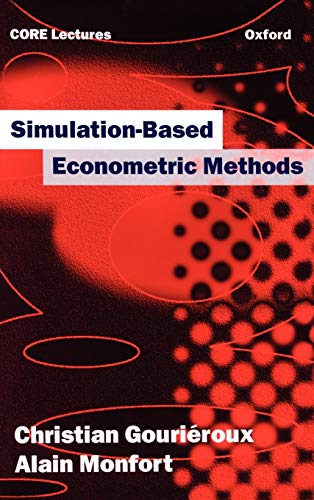
Synopsis
This book introduces a new generation of statistical econometrics. After linear models leading to analytical expressions for estimators, and non-linear models using numerical optimization algorithms, the availability of high- speed computing has enabled econometricians to consider econometric models without simple analytical expressions. The previous difficulties presented by the presence of integrals of large dimensions in the probability density functions or in the moments can be circumvented by a simulation-based approach.
After a brief survey of classical parametric and semi-parametric non-linear estimation methods and a description of problems in which criterion functions contain integrals, the authors present a general form of the model where it is possible to simulate the observations. They then move to calibration problems and the simulated analogue of the method of moments, before considering simulated versions of maximum likelihood, pseudo-maximum likelihood, or non-linear least squares. The general principle of indirect inference is presented and is then applied to limited dependent variable models and to financial series.
"synopsis" may belong to another edition of this title.
About the Author
Christian Gouriéroux is at ENSAE and the University of Paris IX. Alain Monfort is at ENSAE and the École Polytechnique, Paris.
From the Back Cover
Simulation-Based Econometric Methods introduces a new generation of econometric methods in the classical domain. After linear models leading to analytical expressions for estimators and non-linear models using numerical optimization algorithms, the availability of high-speed computing has enabled econometricians to consider econometric models without simple analytical expressions. The previous difficulties presented, for instance, by the presence of integrals of large dimensions in the probability density functions or in the moments can be circumvented by a simulation-based approach.
"About this title" may belong to another edition of this title.
Search results for Simulation-Based Econometric Methods (OUP/CORE Lecture...
Simulation-Based Econometric Methods (OUP/CORE Lecture Series)
Seller: HPB-Red, Dallas, TX, U.S.A.
hardcover. Condition: Good. Connecting readers with great books since 1972! Used textbooks may not include companion materials such as access codes, etc. May have some wear or writing/highlighting. We ship orders daily and Customer Service is our top priority! Seller Inventory # S_416988095
Simulation-Based Econometric Methods Core Lectures
Seller: books4less (Versandantiquariat Petra Gros GmbH & Co. KG), Welling, Germany
gebundene Ausgabe. Condition: Gut. 174 Seiten Das hier angebotene Buch stammt aus einer teilaufgelösten wissenschaftlichen Bibliothek und trägt die entsprechenden Kennzeichnungen (Rückenschild, Instituts-Stempel.). Schnitt und Einband sind etwas staubschmutzig; Einbandkanten sind leicht bestossen; der Buchzustand ist ansonsten ordentlich und dem Alter entsprechend gut. Sprache: Englisch Gewicht in Gramm: 400. Seller Inventory # 1454597
Buy Used
Ships from Germany to U.S.A.
Quantity: 1 available
Simulation-Based Econometric Methods. Core Lectures.
Seller: books4less (Versandantiquariat Petra Gros GmbH & Co. KG), Welling, Germany
Condition: Gut. 174 Seiten; Das hier angebotene Buch stammt aus einer teilaufgelösten wissenschaftlichen Bibliothek und trägt die entsprechenden Kennzeichnungen (Rückenschild, Instituts-Stempel.). der Buchzustand ist ordentlich und dem Alter entsprechend gut. Sprache: Englisch. Sprache: Englisch Gewicht in Gramm: 450 23,0 x 15,6 x 1,8 cm, gebundene Ausgabe. Seller Inventory # 1419972
Buy Used
Ships from Germany to U.S.A.
Quantity: 1 available
Simulation-Based Econometric Methods
Seller: GreatBookPrices, Columbia, MD, U.S.A.
Condition: New. Seller Inventory # 80416-n
Simulation-Based Econometric Methods
Print on DemandSeller: PBShop.store US, Wood Dale, IL, U.S.A.
HRD. Condition: New. New Book. Shipped from UK. THIS BOOK IS PRINTED ON DEMAND. Established seller since 2000. Seller Inventory # L1-9780198774754
Simulation-Based Econometric Methods
Print on DemandSeller: PBShop.store UK, Fairford, GLOS, United Kingdom
HRD. Condition: New. New Book. Delivered from our UK warehouse in 4 to 14 business days. THIS BOOK IS PRINTED ON DEMAND. Established seller since 2000. Seller Inventory # L1-9780198774754
Buy New
Ships from United Kingdom to U.S.A.
Quantity: Over 20 available
Simulation-Based Econometric Methods
Seller: GreatBookPrices, Columbia, MD, U.S.A.
Condition: As New. Unread book in perfect condition. Seller Inventory # 80416
Simulation-Based Econometric Methods (OUP/CORE Lecture Series)
Seller: Toscana Books, AUSTIN, TX, U.S.A.
Hardcover. Condition: new. Excellent Condition.Excels in customer satisfaction, prompt replies, and quality checks. Seller Inventory # Scanned0198774753
Simulation-Based Econometric Methods
Seller: GreatBookPricesUK, Woodford Green, United Kingdom
Condition: New. Seller Inventory # 80416-n
Buy New
Ships from United Kingdom to U.S.A.
Quantity: Over 20 available
Simulation-based Econometric Methods (Hardcover)
Seller: AussieBookSeller, Truganina, VIC, Australia
Hardcover. Condition: new. Hardcover. This book introduces a new generation of statistical econometrics. After linear models leading to analytical expressions for estimators, and non-linear models using numerical optimization algorithms, the availability of high- speed computing has enabled econometricians to consider econometric models without simple analytical expressions. The previous difficulties presented by the presence of integrals of large dimensions in the probability density functions or inthe moments can be circumvented by a simulation-based approach. After a brief survey of classical parametric and semi-parametric non-linear estimation methods and a description ofproblems in which criterion functions contain integrals, the authors present a general form of the model where it is possible to simulate the observations. They then move to calibration problems and the simulated analogue of the method of moments, before considering simulated versions of maximum likelihood, pseudo-maximum likelihood, or non-linear least squares. The general principle of indirect inference is presented and is then applied to limited dependent variable models and to financialseries. This book presents an exciting new set of econometric methods. They have been developed as a result of the increase in power and affordability of computers which allow simulations to be run. The authors have played a large role in developing the techniques. Shipping may be from our Sydney, NSW warehouse or from our UK or US warehouse, depending on stock availability. Seller Inventory # 9780198774754
Buy New
Ships from Australia to U.S.A.
Quantity: 1 available
